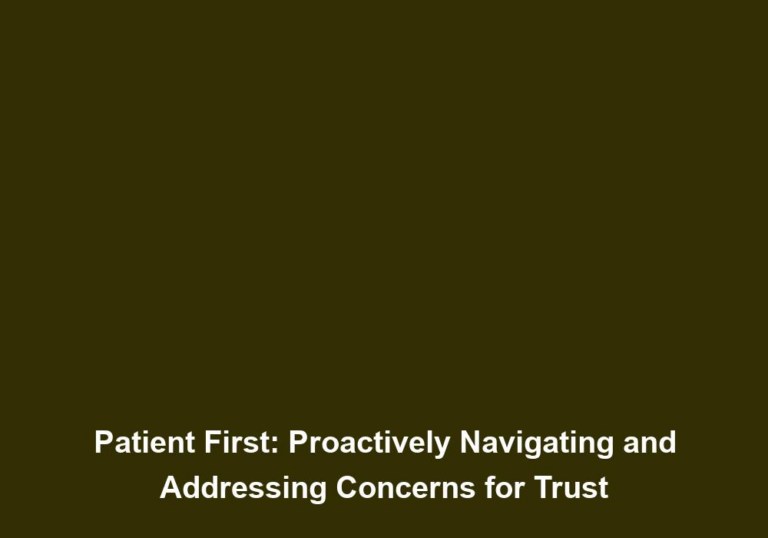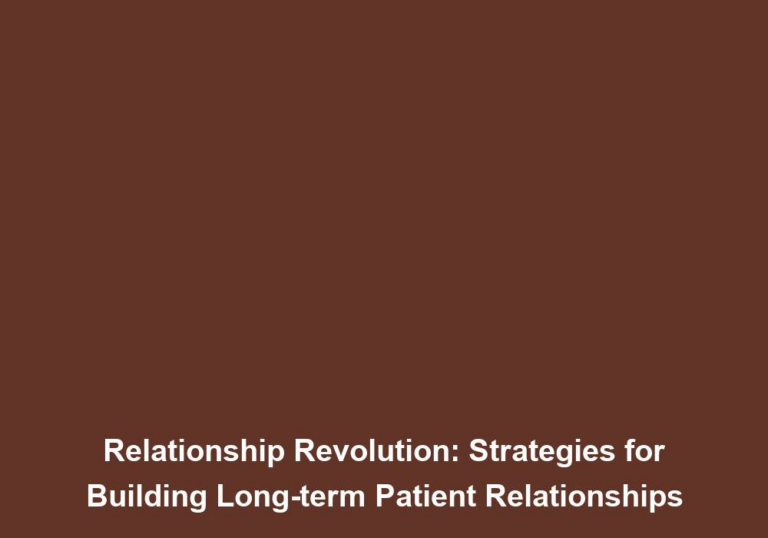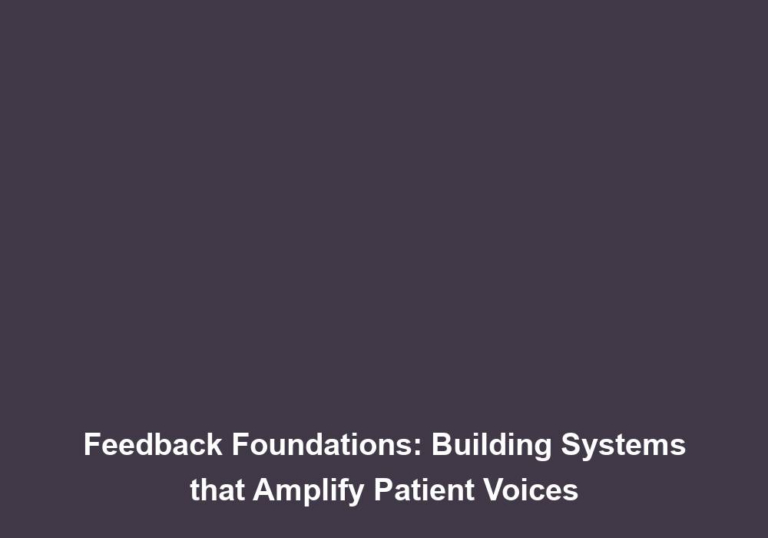The Heart of Healthcare: Embracing Patient-Centric Care Models
In today’s rapidly evolving healthcare landscape, the concept of patient-centric care has emerged as a crucial component in delivering high-quality medical services. This approach places the patient at the center of healthcare decision-making processes, ensuring that their needs, preferences, and values are respected and considered. By adopting patient-centric care models, healthcare providers can enhance the overall patient experience, improve health outcomes, and foster stronger doctor-patient relationships.
Understanding Patient-Centric Care
Patient-centric care is a philosophy that prioritizes the individual’s unique circumstances, values, and goals throughout the entire healthcare journey. It involves actively involving patients and their families in decision-making, promoting open and transparent communication, and tailoring healthcare services to meet their specific needs. This approach recognizes that each patient is unique and requires personalized care that goes beyond just treating their medical condition.
Key Principles of Patient-Centric Care
-
Respect for Patient Autonomy: Patient-centric care recognizes that patients have the right to be involved in their own healthcare decisions. It empowers patients to actively participate in the decision-making process, allowing them to make informed choices that align with their values and preferences. This principle ensures that patients are not just passive recipients of care, but active participants in their own health.
-
Holistic Approach: This approach considers the physical, emotional, social, and psychological aspects of a patient’s well-being. It acknowledges that healthcare extends beyond the treatment of diseases and encompasses the overall quality of life for patients. By taking a holistic approach, healthcare providers can address all aspects of a patient’s health and well-being, leading to improved overall outcomes.
-
Collaborative Decision-Making: By fostering collaborative relationships between healthcare providers and patients, patient-centric care promotes shared decision-making. It involves engaging patients in discussions regarding their treatment options, risks, benefits, and alternatives, ensuring that their voice is heard and respected. This collaborative approach ensures that patients are actively involved in decisions about their own care, leading to better outcomes.
-
Continuity and Coordination: Patient-centric care emphasizes the importance of seamless coordination and continuity of care across different healthcare settings. It aims to prevent fragmented care, reduce medical errors, and ensure that patients receive comprehensive and integrated healthcare services. This principle ensures that patients receive consistent care throughout their healthcare journey, leading to improved outcomes and patient satisfaction.
Benefits of Embracing Patient-Centric Care Models
Adopting patient-centric care models offers numerous benefits for healthcare providers, patients, and the healthcare system as a whole. Let’s explore some of these benefits in detail:
Enhanced Patient Experience
By actively involving patients in their own care, healthcare providers can significantly enhance the patient experience. Patient-centric care ensures that healthcare services are tailored to the individual’s unique needs, preferences, and values. It promotes effective communication, empathy, and respect, which can lead to improved patient satisfaction and a greater sense of trust between patients and healthcare providers. In addition, patients who feel heard and involved in their care are more likely to actively engage in their treatment plans, leading to better overall outcomes.
Improved Health Outcomes
When patients actively participate in their own healthcare decisions, they are more likely to adhere to treatment plans, follow medication regimens, and make necessary lifestyle changes. This level of engagement can lead to improved health outcomes, such as better disease management, reduced hospital readmissions, and enhanced overall well-being. Patient-centric care empowers patients to take control of their health, leading to better self-management and improved outcomes.
Stronger Doctor-Patient Relationships
Patient-centric care models foster stronger doctor-patient relationships by placing an emphasis on open and honest communication. When patients feel valued, listened to, and involved in their own care, they are more likely to trust their healthcare providers. This trust forms the foundation of a strong therapeutic alliance, which can positively impact health outcomes and patient satisfaction. A strong doctor-patient relationship encourages patients to actively participate in their own care and allows healthcare providers to better understand the unique needs and preferences of each patient.
Increased Efficiency and Cost-Effectiveness
While it may seem counterintuitive, patient-centric care models can contribute to increased efficiency and cost-effectiveness in healthcare delivery. By involving patients in decision-making processes, healthcare providers can better understand their unique needs and avoid unnecessary tests, procedures, and interventions. This more targeted approach can help reduce healthcare costs, minimize resource waste, and optimize resource allocation. Patient-centric care ensures that resources are used effectively, resulting in improved efficiency and cost savings for healthcare organizations.
Implementing Patient-Centric Care in Healthcare Organizations
To fully embrace patient-centric care and integrate it into healthcare organizations, certain strategies and practices should be implemented. Here are some key steps healthcare providers can take:
-
Developing a Culture of Patient-Centricity: Healthcare organizations should prioritize patient-centric care as a core value. This involves creating a culture that values patient engagement, open communication, and shared decision-making. It requires educating healthcare providers on the principles and benefits of patient-centric care and encouraging their active participation in its implementation. By fostering a culture of patient-centricity, healthcare organizations can ensure that all staff members are committed to providing the highest quality of care to patients.
-
Enhancing Communication and Information Sharing: Effective communication is a fundamental aspect of patient-centric care. Healthcare providers should strive to improve communication channels with patients, ensuring that information is shared in a clear, understandable manner. This includes providing patients with comprehensive information about their conditions, treatment options, and potential outcomes. Clear and effective communication helps patients make informed decisions about their care and ensures their active participation in the healthcare process.
-
Utilizing Technology: The integration of technology can greatly facilitate patient-centric care. Electronic health records (EHRs), patient portals, and telemedicine platforms can enhance patient-provider communication, streamline care coordination, and improve access to healthcare services. Technology can also enable remote monitoring of patients, allowing healthcare providers to proactively manage their health and intervene when necessary. By leveraging technology, healthcare organizations can enhance the patient experience and improve the efficiency of care delivery.
-
Engaging Patients in Decision-Making: Healthcare providers should actively involve patients in decision-making processes. This can be achieved through shared decision-making tools, decision aids, and patient education materials. Engaging patients in discussions about their treatment options, risks, and benefits can empower them to make informed choices that align with their values and preferences. By involving patients in decision-making, healthcare providers can ensure that the care provided is personalized and meets the unique needs of each patient.
-
Continuously Evaluating and Improving Care: Regular evaluation of patient-centric care practices is essential to ensure their effectiveness. Healthcare organizations should collect feedback from patients, measure patient satisfaction, and identify areas for improvement. This feedback loop allows healthcare providers to continually refine their practices and enhance the delivery of patient-centric care. By continuously evaluating and improving care, healthcare organizations can adapt to the changing needs and preferences of patients, ensuring that their care remains patient-centric.
In conclusion, embracing patient-centric care models is paramount in today’s healthcare landscape. By prioritizing the unique needs, preferences, and values of patients, healthcare providers can enhance the patient experience, improve health outcomes, and establish stronger doctor-patient relationships. Implementing patient-centric care requires a cultural shift, effective communication strategies, technological integration, and active patient engagement. By embracing patient-centric care, healthcare organizations can redefine the future of healthcare and place the heart back into the delivery of medical services.
Note: The above article is written in markdown format for the given title.







